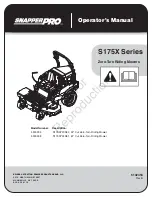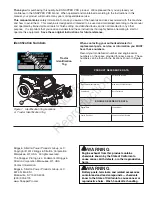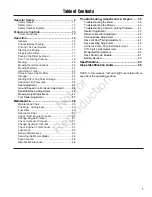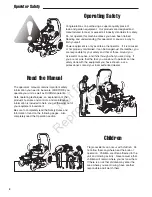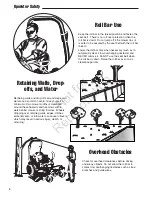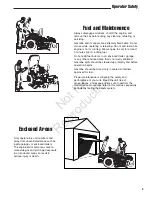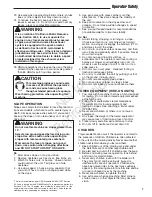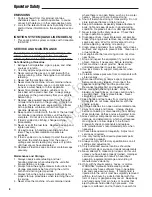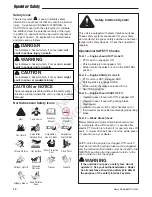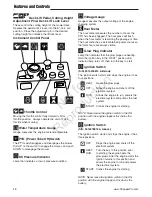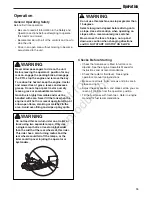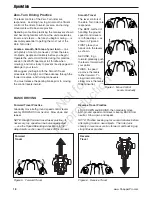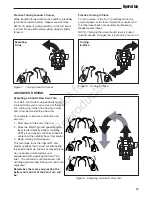
7
Operator Safety
23. Use care when approaching blind corners, shrubs,
trees or other objects that may obscure vision.
24. To reduce fire hazard, keep unit free of grass,
leaves & excess oil. Do not stop or park over dry
leaves, grass or combustible materials.
25. OSHA regulations may require the use of hearing
protection when exposed to sound levels greater
than 85 dBA for an 8 hour time period.
SLOPE OPERATION
Slopes are a major factor related to loss-of-control and
tip-over accidents, which can result in severe injury or
death. All slopes require extra caution. If you cannot
back up the slope or if you feel uneasy on it, do not
drive on it.
Do
1. Mow across slopes, not up and down.
2. Remove obstacles such as rocks, tree limbs, etc.
3. Watch for holes, ruts, or bumps. Uneven terrain
could overturn the unit. Tall grass can hide
obstacles.
4. Use slow speed. Choose a slow speed so that
you will not have to stop or change speed while
on the slope.
5. Use extra care with grass catchers or other
attachments. These can change the stability of
the unit.
6. Keep all movement on the slopes slow and
gradual. Do not make sudden changes in speed
or direction.
7. See your authorized dealer for recommendations
of available weights to improve stability.
Do Not
1. Avoid starting, stopping, or turning on a slope.
If tires lose traction (i.e. machine stops forward
motion on a slope), disengage the blade(s) (PTO)
and drive slow off the slope.
2. Do not turn on slopes unless necessary, and then,
turn slowly and gradually uphill, if possible. Never
mow down slopes.
3. Do not mow near drop-offs, ditches, or
embankments. The operator could lose footing or
balance or mower could suddenly turn over if a
wheel is over the edge of a cliff or ditch, or if an
edge caves in.
4. Do not mow on wet grass. Reduced footing or
traction could cause sliding.
5. Do not try to stabilize the unit by putting your foot
on the ground. (ride-on units)
6. Do not mow excessively steep slopes.
7. Do not use grass catcher on steep slopes.
8. Do not mow slopes if you cannot back up them.
TOWED EQUIPMENT (RIDE-ON UNITS)
1. Tow only with a machine that has a hitch designed
for towing. Do not attach towed equipment except
at the hitch point.
2. Follow the manufacturer’s recommendations
for weight limit for towed equipment and
towing on slopes. See attaching a trailer under
OPERATION.
3. Never allow children or others in or on towed
equipment.
4. On slopes, the weight of the towed equipment
may cause loss of traction and loss of control.
5. Travel slowly and allow extra distance to stop.
6. Do not shift to neutral and coast down hill.
CHILDREN
Tragic accidents can occur if the operator is not alert to
the presence of children. Children are often attracted
to the unit and the mowing activity. Never assume that
children will remain where you last saw them.
1. Keep children out of the mowing area and under
the watchful care of another responsible adult.
2. Be alert and turn unit off if children enter the area.
3. Before and during reverse operation, look behind
and down for small children.
4. Never carry children, even with the blade(s) off.
They may fall off and be seriously injured or
interfere with safe unit operation. Children who
have been given rides in the past may suddenly
appear in the mowing area for another ride and be
run over or backed over by the machine.
5. Never allow children to operate the unit.
6. Use extra care when approaching blind corners,
shrubs, trees, or other objects that may obscure
vision.
CAUTION
This machine produces sound levels
in excess of 85 dBA at the operator’s
ear and can cause hearing loss
though extended periods of exposure.
Wear hearing protection when operating this
machine.
WARNING
Do not use this machine on slopes greater than
15°.*
Select slow ground speed before driving onto
slope. Use extra caution when operating on
slopes with rear-mounted grass catchers.
Mow across the face of slopes, not up and
down, use caution when changing directions
and DO NOT START OR STOP ON SLOPE.
*This limit was determined per CEN Standard EN 836:1997, Section
5.2.2 and is based on the EN 836 Stability Test procedure described in
Section 4.2.4.2. The 15 degree “limit of stability” is equal to 50% of the
angle at which machine lift-off occurred in static tests. Actual dynamic
stability may vary depending on operating conditions.
WARNING
It is a violation of California Public Resource
Code, Section 4442, to use or operate the
engine on any forest-covered, brush-covered
or grass-covered land unless the exhaust
system is equipped with a spark arrester,
as defined in Section 4442, maintained in
effective working order. Other states or federal
jurisdictions may have similar laws. Contact
an Authorized Service Dealer to obtain a spark
arrester designed for the exhaust system
installed on this engine.
Not
for
Reproduction
Содержание 5900935
Страница 58: ...Notes N o t f o r R e p r o d u c t i o n ...

